Mayflies
April 30 2006

Insects of the order Ephemeroptera are commonly known as Upwinged Flies or Mayflies. They are found in fresh water around the globe occupying both lakes and rivers with species adapted to several different niches. The mayflies number 200 species in Europe (50 in the UK); around 570 in North America; New Zealand has at least 40; Australia has over 80; and South America has nearly that many put together.
Life Cycle
The mayflies’ life cycle consists of an incomplete metamorphosis, having stages as egg, nymph, dun (subimago) and spinner (imago).
The eggs of many species, like the Pale Evening Dun (Procloeon bifidum (UK)), are deposited by the female on the surface over open water. There the eggs sink and attach to aquatic plants, rocks and other features of the substrate. Some species crawl beneath the water surface to oviposit. The eggs, of which the adult may lay several thousand, generally hatch after a period of between one and three months. Longer and shorter incubation periods occur in a limited number of species and under certain prevailing conditions.
After hatching, the nymphs feed on algae, plant debris, and other small food particles carried in the current. They grow through several instars before reaching maturity. This takes from a few months to a couple of years, once again depending on species and prevailing conditions, and also time of year when the eggs were laid.
When mature and ready to emerge, the nymphs of species like the Iron Blue Dun (Nigrobaetis niger) will swim to the water surface to hatch. Other species like the Pale Evening Dun (Ephemerella dorothea (US)), hatch under water and float to the surface before flying away. Gray Drakes (Siphlonuridae siphlonurus (US)), crawl out of the water to hatch using stones and plant stems.
Adults emerge from their nymphal skin through a split at the back of the thorax. Once free of their skins (now referred to as shucks) the duns fly to cover. After a couple of days, the duns moult and emerge sexually mature adults. Some species transform into the spinner more quickly, while two species forgo the imago stage altogether:Palingenia and Ephoron. The life cycle is completed when the spinners mate and return to the water to lay their eggs.
Nymphs
The nymphs of different mayfly species fill six separate niches in their aquatic environment and this is reflected in their various physical forms. They are generally categorized as Bottom Burrowers, Silt Crawlers, Moss Creepers, Stone Clingers, Laboured Swimmers, and Agile Darters. They are olive, brown, and cream in colour, with variations of shade. The nymph’s form consists of three sometimes quite long tails, a tapered and segmented body that usually bares gills. The thorax is sometimes pronounced and has three pairs or legs attached. The thorax also carries wing buds that are most developed in the mature nymph.
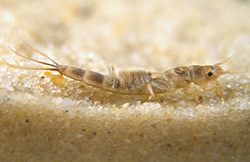
The Bottom Burrowers, consist mainly of species from the genera Ephemera, Hexagenia (US), Palingenia(EU) and Ephoron. They are the largest of the mayflies growing to 35mm in length. The nymphs have large feather-like gills, ‘developed’ legs, and tusk-like mandibles. They have two or three tails, sometimes fringed with fine hairs. They can be found in both rivers and lakes where the substrate is soft, fine sand or gravel. The nymphs dig burrows where they retreat by day emerging at night to feed. Inside their burrows the nymphs constantly fan their gills to obtain sufficient oxygen. These nymphs can swim quite effectively but avoid doing so until they are ready to emerge. At that point the nymphs swim to the surface and the adult hatches out through the surface film. Fish often take the rising nymphs before the duns so that presenting a swinging and rising artificial can be very effective.
The Silt Crawlers, consist of species from the genera Tricorythodes (US) andCaenis. These are the smallest mayflies; the nymphs grow to between 3 and 6mm. They have small gills on top of the abdomen, and three tails. They are poor swimmers but have good camouflage. They can be found in both rivers and lakes where they crawl along the bottom feeding on algae and plant debris. These nymphs crawl from the water to hatch so that fishing a nymph pattern is of questionable worth.
The Moss Creepers, are from the family Ephemerellidae and include species like the Blue-winged Olive (Serratella ignita (UK)). The nymphs grow to between 6 and 12mm. They have oval gills held over the abdomen. They are similar to the Baetis nymphs only more boldly marked, a little more compact, and very slightly flattened in appearance. They are found only in rivers where they creep and crawl amongst dense weed, water moss, and plant debris. They are often found at current seems where deposits of decaying plant material accumulates. Fish do forage for these nymphs but otherwise prey upon them most either when they get washed into the drift or when they swim to the surface to hatch.
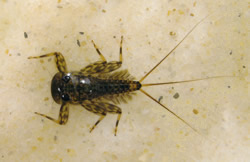
The Stone Clingers, are from the family Heptageniidae including species from the genera Rhithrogena , Ecdyonurus, Epeorus, Heptagenia and Oligoneuriella. They grow to 15mm in length and appear relatively broad compared to other varieties. They have an extremely flattened side profile that allows them to inhabit stone surfaces in fast water flows. From above the nymph has a wide head (as wide if not wider than the thorax and abdomen) on top of which are two prominent eyes. The abdomen supports divided or disc shaped gills at the sides. The legs have flattened and developed femurs. Like their title suggests, the stone clingers tend to live on the surfaces of rock on the river bed, spending most of their time on the lower surfaces out of the main current and only moving to the outer surfaces in low light. Mostly the stone clingers do not feature high on the fishes’ menu; however, when a river has heavier than average flow rates nymphs can become dislodged and fish will take them from the drift. Occasionally fish will forage for them. Fish a drag free upstream nymph or a rising nymph during a hatch.
The Laboured Swimmers, are from the family Leptophlebiidae, including the generaLeptophlebia and Paraleptophlebia (US). Species include the Sepia Dun (Leptophlebia marginata) and Mahogany Dun (L. vespertina). The nymphs grow to 12mm. They have forked gills at the sides of the abdomen. They have three long tails that are almost entirely without hairs. They are found in lakes or slow-flowing streams where they crawl amongst reeds, weed, and rock. The nymphs only form a significant menu item when they swim to the surface to hatch. Presenting an emerger at or just below the surface is an effective tactic.
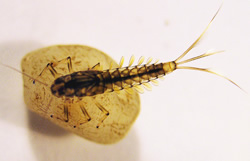
The largest group are the Agile Darters coming from the families Baetidae and Siphlonuridae including generaBaetis, Callibaetis, Pseudocleon, Procloeon, Centroptilum, Cloeon, Siphlonurus, Ameletusand Isonychia. Species include the Large Dark Olive (Baetis rhodani) and the Pond Olive (Cloeon dipterum). The nymphs grow to between 5 and 15mm. They are slim in appearance with disc shaped gills at the sides of the abdomen. They nearly always have three hair-fringed tails. They are found in diverse water habitats including lakes, slow-flowing streams, and fast riffled streams. The nymphs swim or dart about by moving their abdomen and tails with an up and down flicking motion. Their free swimming tendencies combined with their large numbers mean they form a significant proportion of the drift both mornings and evenings putting the agile darters high on the fishes menu. Presenting a dead drifted nymph or a twitched nymph is very effective in drawing a strike from fish picking these nymphs from the current. You could do worse than fishing a slim dressed and lightly weighted Gold Ribbed Hares Ear.
Adults
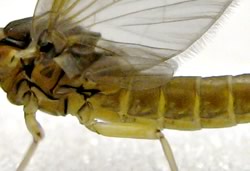
Immature adults or duns have veined wings, usually opaque and fringed with tiny hairs. At rest the wings are held together vertically – hence the name ‘Upwinged’ flies. The forewings are relatively large at least as long as the body, while the hind wings are usually significantly smaller. In some species the hind wings are absent altogether. The specific characteristics of a species’ wings form a key element in distinguishing one from another. The body of the dun is usually dull coloured and has two or three long tails. Where species emerge in open water fish will feed on the dun as it struggles free of its shuck or during the brief time the insect pauses before taking flight. Present matching emerger patterns and dry flies to intercept the feeding fish.
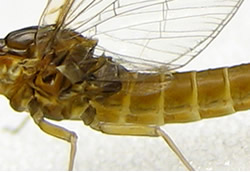
The spinner is typically more deeply coloured, has almost transparent veined wings free of hair, with tails often extended longer than the dun. Below their tails the male spinners have two claspers that they use to hold the female while mating. The males also have more extended front legs to assist mating. After their final moult the newly emerged male spinners swarm in the air either near bank side vegetation or away from the water over adjoining land. The females fly into the swarms to mate and once impregnated, fly back to the water to lay their eggs. After mating and egg-laying the spinners die. Depending on the species several scenarios can result in prime opportunities for the angler. Where the insects swarm over the water their eventual death produces a ‘fall’ on the water, and if you’re lucky a heavy rise of fish. That’s the time to cast out your poly wings and clipped hackle dry flies. Where spinners dive below the surface to lay their eggs they often end up caught in the general drift below the surface. Fish may appear to be ‘nymphing’ at this time so try not to forget the ‘sunk spinner’ or good old fashioned hackled wet fly might be the key to success.